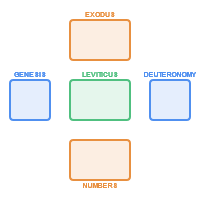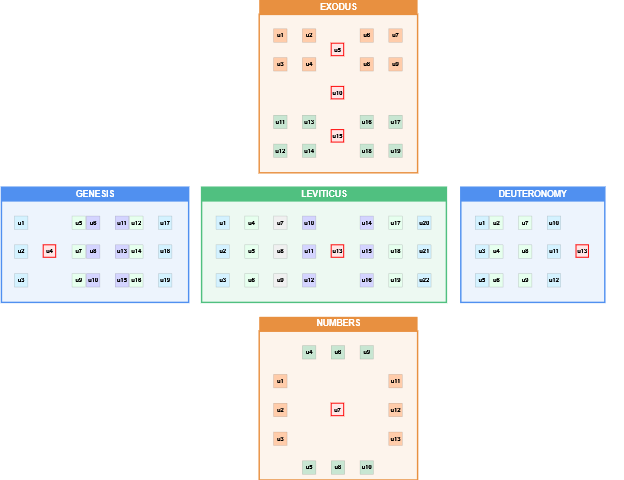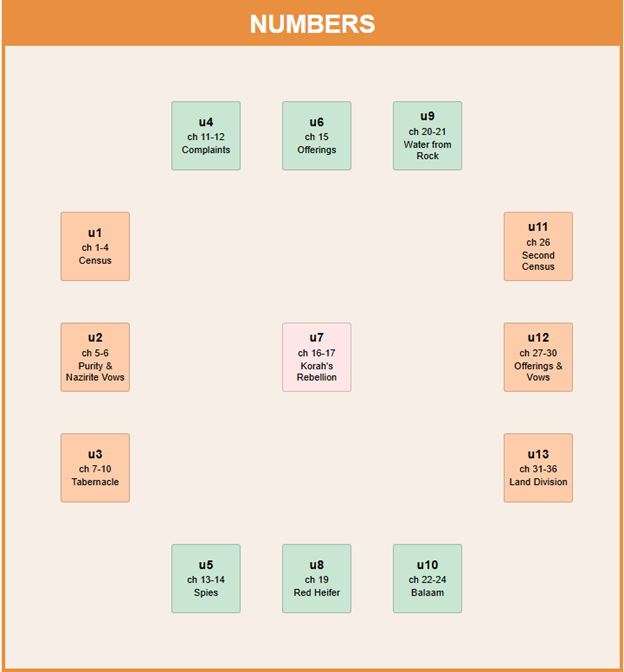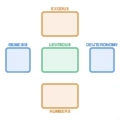About the Woven Texts Project
Discovering Biblical Literature's Multilayered Structure
The Woven Texts project presents a fresh approach to exploring biblical literature. Rather than viewing these texts as a simple sequence of stories and laws, we invite you to discover them as an intricate tapestry with meaningful patterns that become visible at multiple levels.
The Five-Book Weave
As our logo illustrates, the five books of the Torah form a beautiful woven pattern:
- The horizontal thread connects Genesis through Leviticus to Deuteronomy, spanning the entire history from creation to Israel's future.
- The vertical thread runs through Exodus, Leviticus, and Numbers, focusing on the 40-year journey through the wilderness.
Leviticus sits at the crucial intersection point where these threads meet, binding the entire structure together. This arrangement isn't random—it reflects deep thematic and structural connections between the books.

The Woven Texts logo illustrates how the five books form an integrated structure
A Tapestry on Three Levels
What makes the Woven Texts approach revolutionary is the discovery that the same weaving paradigm exists at three integrated levels:
- The entire text as a tapestry of books
- Each individual book as a woven structure of literary units
- Each literary unit as a weave of textual elements
This multilayered weaving isn't coincidental – it reveals an intentionally designed literary framework that conveys meaning through its very structure. The high-level patterns visible in the relationship between the books naturally draw readers to explore the lower levels, where they discover similar weaving patterns repeating at progressively finer scales.
The Three Levels of Weaving

Map showing the five books of the Pentateuch
Level 1: The Complete Text
The complete text as a woven tapestry with horizontal and vertical threads connecting books

Example of a Book Map showing the structure of Numbers
Level 2: Individual Books
Each book contains its own unique woven structure of literary units

Example of a Unit Map showing the structure of a literary unit
Level 3: Literary Units
Each unit is a two-dimensional weave revealing parallel elements and patterns
A Natural Structure
The Woven Texts approach organizes the text into literary units that reveal the inherent structure, rather than following the traditional chapter divisions that were added in medieval times. These units aren't simply sequential blocks but contain internal weaves of their own, creating a coordinate system of meaning that helps you see connections between passages that aren't apparent in a linear reading.
Visual Maps for Exploration
Our website features three types of maps that help you navigate the woven structure at each level:
- The Complete Text Map - Shows how all books work together as a unified whole
- Individual Book Maps - Displays the unique woven structure of each book
- Literary Unit Maps - Presents the actual text with its internal patterns and parallel elements
As you move from the highest level to the most detailed, you'll notice that the same weaving principles appear at each stage, revealing a remarkable consistency of design throughout the text.
The Hidden Design
One of our most exciting discoveries is that biblical books mirror each other in meaningful ways. As our analysis shows, Genesis and Deuteronomy balance each other like bookends, with Leviticus at the center forming a pivot point. Similarly, Exodus and Numbers create a balanced frame for the wilderness journey.
The structure of texts themselves often reflects deeper metaphysical concepts, with concentric rings around central cores containing essential theological principles. This arrangement suggests that the very organization of the text carries theological meaning.
Core Principles
Highlighting the unique contributions of the Woven Texts project to the academic study of biblical literature and its composition.
Scholarly Approach
Our work employs rigorous analysis to unveil the literary structures within biblical texts, fostering academic discourse and research.
Interactive Visualization
Our visual maps offer comprehensive visualization, illustrating the interconnections among texts and enhancing understanding.
In-Depth Analysis
Each literary unit is meticulously examined, presenting its woven structure in a clear, color-coded format for deeper insight.
Multilayered Approach
Our unique three-level structure reveals how the same weaving principles exist from the macro to micro levels.
Experience Biblical Texts Anew
The Woven Texts approach isn't just for scholars—it's for anyone who wants to discover new dimensions in these ancient texts. By recognizing the sophisticated weaving patterns at all three levels, readers of all backgrounds can gain fresh insights and appreciate the unity and purpose of biblical literature in ways that linear reading alone cannot reveal.
We invite you to explore our maps, study the literary units, and experience biblical texts as beautifully crafted wholes. Each level you explore will deepen your understanding of how form and content work together to create meaning in these foundational texts.
"The study of biblical texts as tapestries reveals interconnections that transform our understanding of their message at every level."
